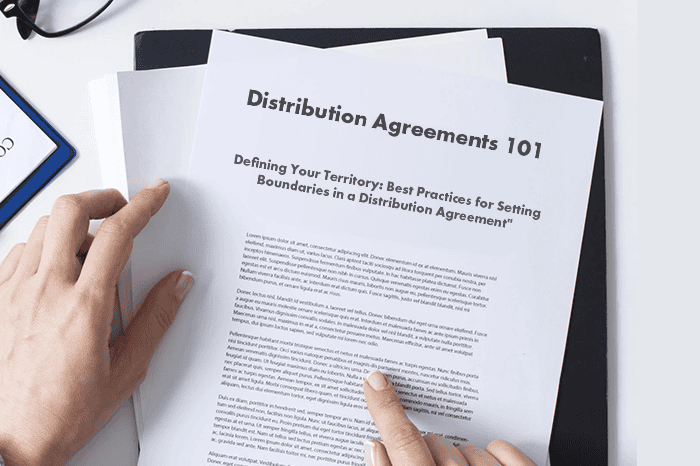Raveena Rani
Raveena is a seasoned International IP Counsel with a unique blend of engineering and legal acumen, specializing in Intellectual Property, Technology Law, and Corporate Transactions. She has extensive experience drafting and negotiating NDAs, commercial agreements, and legal documents in the areas of M&A, SaaS, and AI. Her global perspective is complemented by hands-on internships, corporate counsel roles, and mentoring initiatives. She thrives at the intersection of law, business, and technology.
Need any help? Contact us:

Table of Contents

A distribution agreement is a formal contract that specifies the terms and circumstances of a supplier and distributor’s commercial relationship. Establishing specific limits for the distributor’s operational area, marketing and promotion efforts, and sales activities is one of the important elements of a distribution agreement.
In order to establish a successful and mutually advantageous commercial relationship between the distributor and supplier, a distribution agreement must set boundaries. Both parties can collaborate more successfully while upholding the integrity of the business relationship by clearly defining the parameters and restrictions that apply to the operations of the distributor and supplier.
There are best practices that should be followed in order to establish limits that work. They include establishing marketing and promotion restrictions, defining the territory, limiting customers or end users, establishing non-compete terms, taking into account exclusivity, and inserting clauses for adjusting borders.
Purpose of Defining Boundaries in a Distribution Agreement
To develop a clear knowledge of the distributor’s permitted area of trade and to avoid any confusion concerning the type of activities a distributor is allowed to indulge in, boundaries are specifically written in the distribution agreement. Through it, both parties can collaborate more successfully. It allows businesses to while upholding the integrity of their relationship by clearly defining the restrictions that are applicable.
A distribution agreement’s definition of the area is crucial for determining which markets the distributor is permitted to serve. This also extends to the regions within which a supplier has the option of reserving or designating to another distributor. A supplier may employ different distributors for different regions. This prevents any unhealthy competition between distributors and resolves conflict that may occur between the supplier and the distributor.
A distribution agreement should specify the region while defining the terms for restricting customers or end users. This should be done while establishing marketing and promotion limitations extending to non-compete agreements. Therefore, while defining the boundaries, suppliers need to take the status of exclusivity into account and incorporate measures for revising the boundaries.
Both sides can establish a substantial and prosperous business relationship that benefits the distributor and the supplier mutually. This can be achieved by specifying precise and suitable boundaries in a distribution agreement. To ensure that the limitations outlined in the agreement are reasonable and enforceable, it is essential to discuss them with business and legal experts. Legal experts can administer the identification of any potential legal difficulties. This will warrant that the language used in the agreement to define the boundaries is clear and succinct.
Best Practices for Setting Boundaries in a Distribution Agreement
You can follow these steps to set boundaries in a distribution agreement:
- Define the Territory of your distributors:
Define the geographic area where the distributor is authorised to sell or distribute the products. This will help avoid misunderstandings or conflicts regarding the distributor’s area of operations.
- Set Limitations on Customers:
Set restrictions on the types of customers or end-users to whom the distributor may sell, such as sales to competitors or unauthorized markets. This will aid in ensuring that the supplier’s products are sold to the right customers or end-users.
- Establish Marketing and Promotion Restrictions:
Set limits on product marketing and promotion, such as guidelines for advertising, packaging, and labelling. This will help to preserve the supplier’s brand’s integrity and reputation.
- Include Non-Compete Clauses:
Non-compete clauses should be included in the agreement to prevent the distributor from competing with the supplier or selling competing products during the term of the agreement.
- Consider Exclusivity for your distributors:
Consider whether the distributor should be awarded exclusive or non-exclusive rights to sell or distribute your products in the specified territory. If there is little demand within the designated territory, exclusivity may also reduce potential revenue. Exclusivity can help to foster a sense of ownership and brand loyalty, creating a sustainable customer base.
- Include Provisions for Modifying Boundaries:
Include provisions in the agreement for future boundary modifications. This could entail expansion of the territory or changes in the restrictions on customers or end-users. This allows for adaptability as the business relationship and its evolution over time.
Conclusion
Setting boundaries in a distribution agreement is critical for establishing a prosperous and mutually advantageous business relationship between the distributor and supplier. Setting clear limitations and restrictions on the distributor’s and supplier’s operations allows both parties to cooperate effectively while sustaining the integrity of the business relationship.
To establish effective boundaries, the companies can define the territory, incorporate non-compete clauses, limit customers or end-users, consider exclusivity, establish marketing and promotion regulations, and include provisions for changing boundaries. These practices can help to avoid conflicts arising from misunderstandings, or agreement violations. Setting boundaries protect the interests of both parties.
Working with legal experts is necessary to ensure that the boundaries established in the agreement are appropriate and enforceable. Legal experts can help you identify potential legal issues that may arise from unresolved conflicts. This will also warrant that the language used in the agreement is clear and concise.
You might also like:
- Distribution Agreements 101: Balancing Risks and Rewards (Part-1)
- Distribution Agreements 101: Importance of Pricing and Payment Terms (Part-2)
- Distribution Agreements 101: Termination Clauses and Protecting Interests (Part-3)
- Distribution Agreements 101: Exclusive and Non-Exclusive Clauses (part-4)
- Distribution Agreement Template





